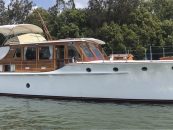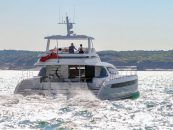At sixteen, I sailed from Beauty Point in Tasmania on a 35ft trimaran leaving my mum crying on the jetty. It took four days to sail across Bass Strait. The strait was like a millpond just miles and miles of calm water and mild breezes—just paradise, something no one believes. Then the weather hit. Seven days at sea saw us somewhere near Lord Howe Island. Eventually, the storm subsided enough that we could turn back toward Australia. There were four of us on board—no radio, no auto pilot, just a compass for navigation. The skipper was seasick and vomited every time he looked at the chart. And the rest of the crew were too scared to go on deck. I sat for countless hours tied on at the tiller with the waves smashing over me while going up and down mountains of water. Every time the boat crested a wave, I had to pull the tiller hard over so she headed down the wave without capsizing. I don’t remember being afraid, but I do remember thinking, “If I’m going to die, this is where i want to be.”
When we finally hit the Aussie coast again at Newcastle, the harbour was closed. The swell was too big for ships to enter. The captain decided to go in anyway. He had had enough. Navigating about 100 anchored ships, we caught a wave on the breakwater and surfed into the harbour. There were surfers on their board beside us cheering us on. If i had known then what i do now, I would never have gone on that boat.
After spending another six months on the Tassie Trier, heading north in much calmer conditions, I jumped ship in the Whitsundays and worked on cruise boats, including Gretel, Apollo and Trusan. Over the next many years, I sailed on Supercat to New Guinea, Palau and the Philippines, the Greek islands, Corfu, along the French Rivera, and a few years ago, at the amazing Kimberly’s on Mick Vaudrey’s boat, the Graymac.
Let me introduce Wild Goose
My then husband and I purchased the Wild Goose in 2008 and moved on board. I had searched the world for the right boat and I found her on the Gold Coast. We did a bit of a refit then sailed north as far as Hervey Bay. He lasted less than 12 months. “It’s not for everyone,” he said. I kept the boat.
The Wild Goose is a 65ft aluminium Crowther catamaran. She was built in South Africa in 1998 to Australian survey standards (most likely by an Australian, but I have no history of her). In my eyes, she is the perfect long-haul sailing vessel. She’s 30ft wide for maximum stability, has six crash bulkheads, separate engine rooms, and an enclosed helm. (No more white water for me!) Powered by twin 120hp Yanmar diesel engines, she turns on her length and has plenty of sail area producing a reasonable speed for such a large heavy boat. The Goose averages 6 to 10 knots, or half-wind speed under sail (although I have recorded 17.9 knots in 30 knots of breeze).
We have all the important things for ocean crossing, including radar. And just in case one fails, there are two GPS systems. The auto pilot, wind and depth instruments are all Simrad. They are all a bit old but easy to use and reliable. When at sea we use the radar to set an alarm that notifies us if any ships come into our perimeter. It is possible to connect the auto pilot to the GPS to plot a course and let the boat steer herself, but I prefer to keep a watch. Safety first!
Wild Goose has a large battery bank run by a 6kva generator and 8 solar panels. In summer, there is not much need for the generator as the panels provide about 40-amp hours. The inverter gives us 240-volt power. We have a water maker for fresh water when in other countries. The Goose has four double cabins, a large saloon and an enclosed cockpit. There are three bathrooms and three heads. Two of these heads are macerators to tank with pump-out or at-sea release. The other is a day head that can be used at sea but not in port. The most important for an aluminium boat are sacrificial anodes (metals attached to the hull). Without anodes, electrolysis (corrosion) would gradually eat the boat away. Unlike other construction materials, antifouling is not really necessary on aluminium. Although growth will attach to the boat, they cannot do any harm and can be easily scraped off.
It’s hard to say when my passion for the ocean began. I don’t think I have ever been any different. Maybe it is in my genes. There are pirates in my ancestry! Arhhh! As a child I have memories of waiting for the tide to come in so I could launch the dingy. I don’t think I chose this lifestyle. To me, the ocean is my home. Every time I leave a seaway, I get a tear in my eye and an overwhelming feeling of belonging. My happy place is doing the Titanic over the bow of the Wild Goose.
Adventures with Wild Goose begins
It took me a couple of years to get my footing again before heading to New Caledonia and Vanuatu in 2014 with my son, Taylor, and his girlfriend, and my now partner, Troy, on board. After clearing customs in Australia, we spent seven days at sea before entering Port Bourail, about half way up the New Caledonia coast. We made a slight miscalculation as we were heading for Noumea, but ended up safe and sound nonetheless.
We spent quite a few months in New Caledonia. The country is an absolute paradise for sailors once you leave the city of Noumea. There are wonderful surfing breaks everywhere, amazing islands to explore and no people. Best of all, the country is boat-friendly. Customs check—in and out—is easy with very minimal fees.
As for other future adventures, I would leave tomorrow. I’m 52 now and getting itchy feet again. Anywhere is good. I can live in Asia and probably will in the next few years.
There is much media hype about pirates in Asia, and I have no doubt they are out there. But I have never seen any. One of the smartest safety devices I have seen is 12-volt electric handrails, like a horse fence, enough of a deterrent if you were being boarded to at least make them think twice. In my experience, if you show respect for the country, their religion and their politics, you are safer than crossing the road at Surfers Paradise. (Although there was times In New Guinea, I did feel like i could have been on the lunch menu!)
Most of the time, the locals are excited to see you. In the Philippines, I even met the mayor of Dinagat escorted by about 50 children from the local school. They had never seen a white woman. I was treated like a princess given special gifts of orchids and local shells.
Money is always the main problem for extended journeys. It costs very little to live aboard at anchor. No rates or taxes, water or electricity. Diesel and maintenance are the only real expenses. But to travel overseas, you need funds to get you there and back—mishaps included. You are always at the mercy of the weather and time frames are unpredictable.
The Wild Goose is a big boat, plenty of room for crew, family and friends. I’m not into solo sailing—sounds boring to me. Good company and good times make for a happy life. We do not go to sea in rough weather. We pick the weather carefully. These days, we have all the tools we need to do so. Only fools challenge Neptune! In any case, I’m a small person, so I need crew if something goes wrong. I don’t have the strength to pull down a torn sail or pull up the anchor if the winch fails. So when i go off shore I need the right people with me. Patience and calm in an emergency is vital on board. When you are heading for a reef and your steering has failed, panicking doesn’t help.
Except for getting in the tender to go to shore, living aboard the Wild Goose is much like living in a four-bedroom house. Best of all, you can travel without packing a suitcase. And you can take the kitchen sink!
On buying a sailboat: “Hire one first. Sail to sea on any boat you can crew on before you commit to the purchase. Learn the ropes—don’t trip over them. After all, a wise woman once said, ‘Better than a boat is a friend with a boat.’”
By Lyndell James, a passionate sailor whose love for ocean sailing is as natural as the ocean itself. She takes us with her on her journey before Wild Goose, and then beyond.




























